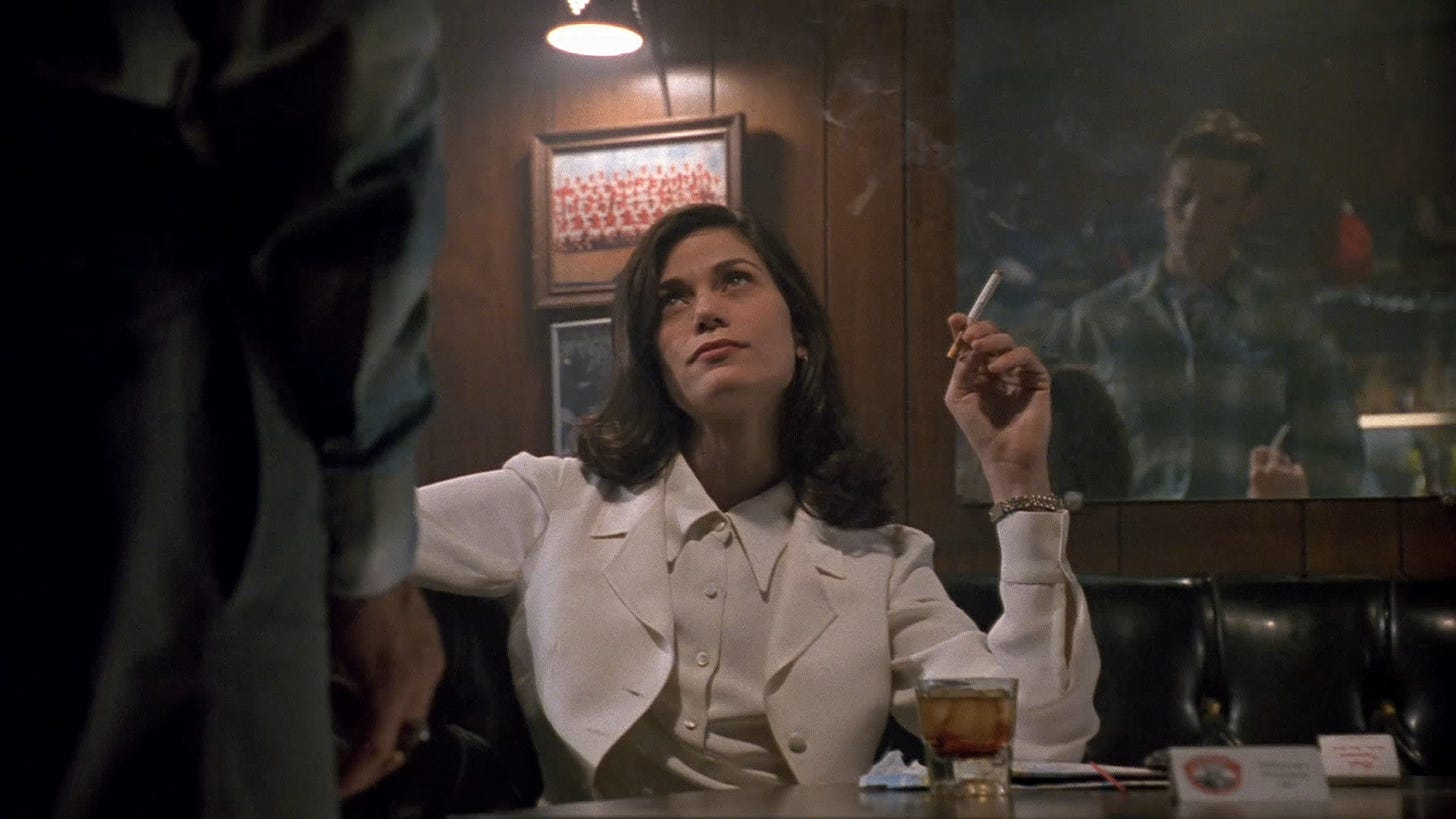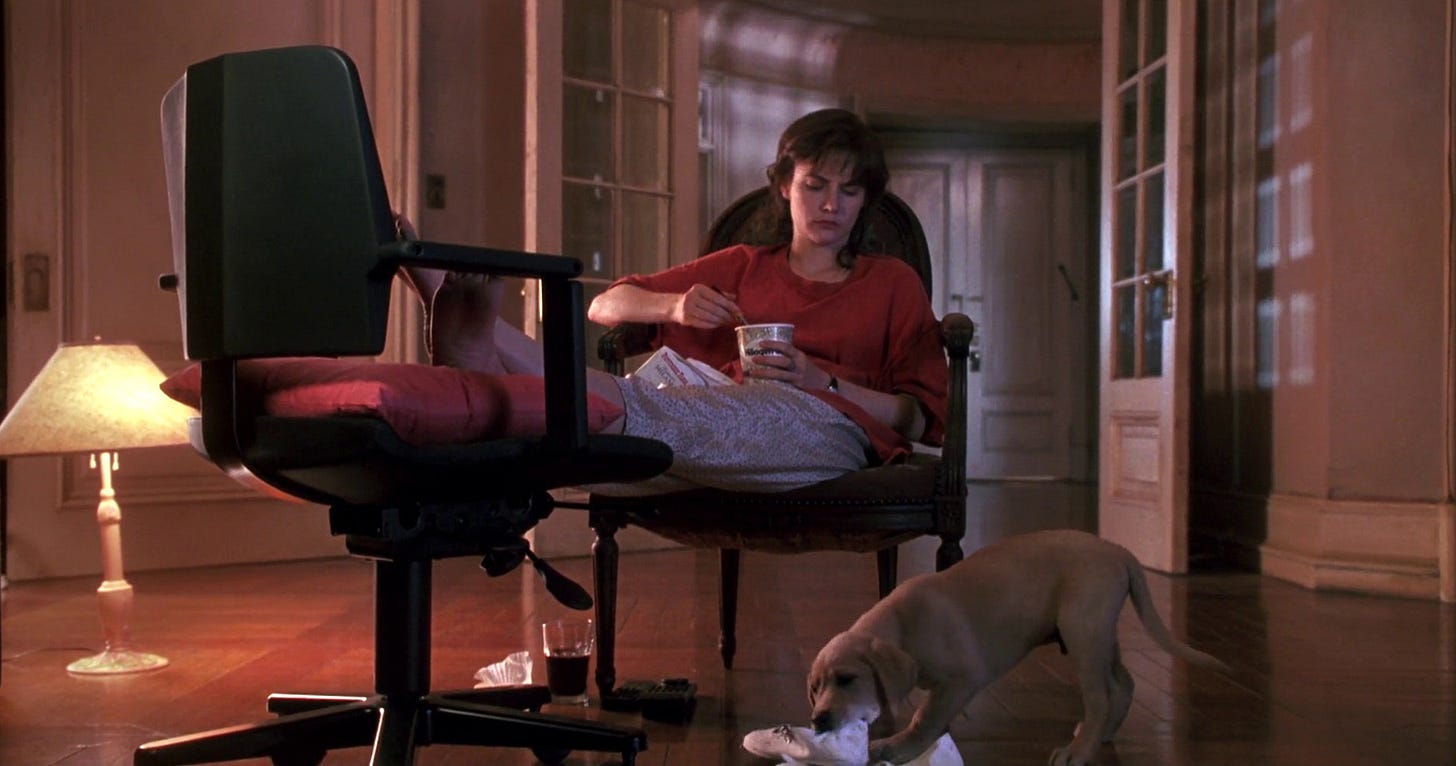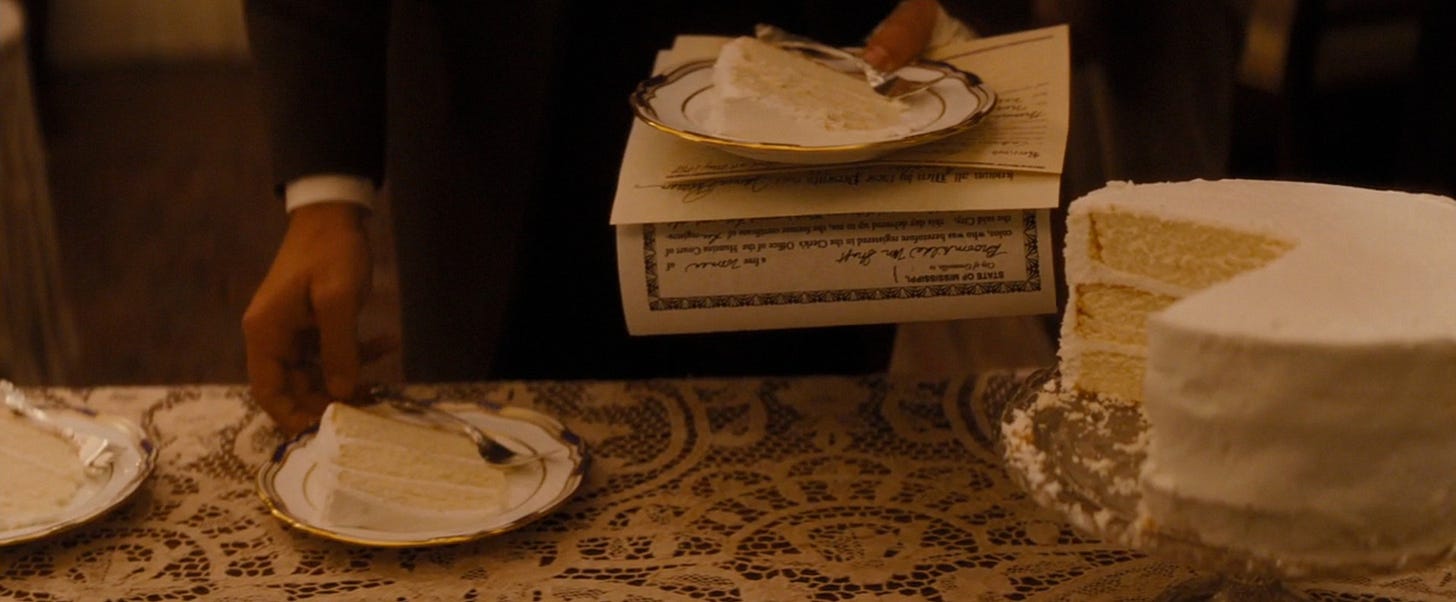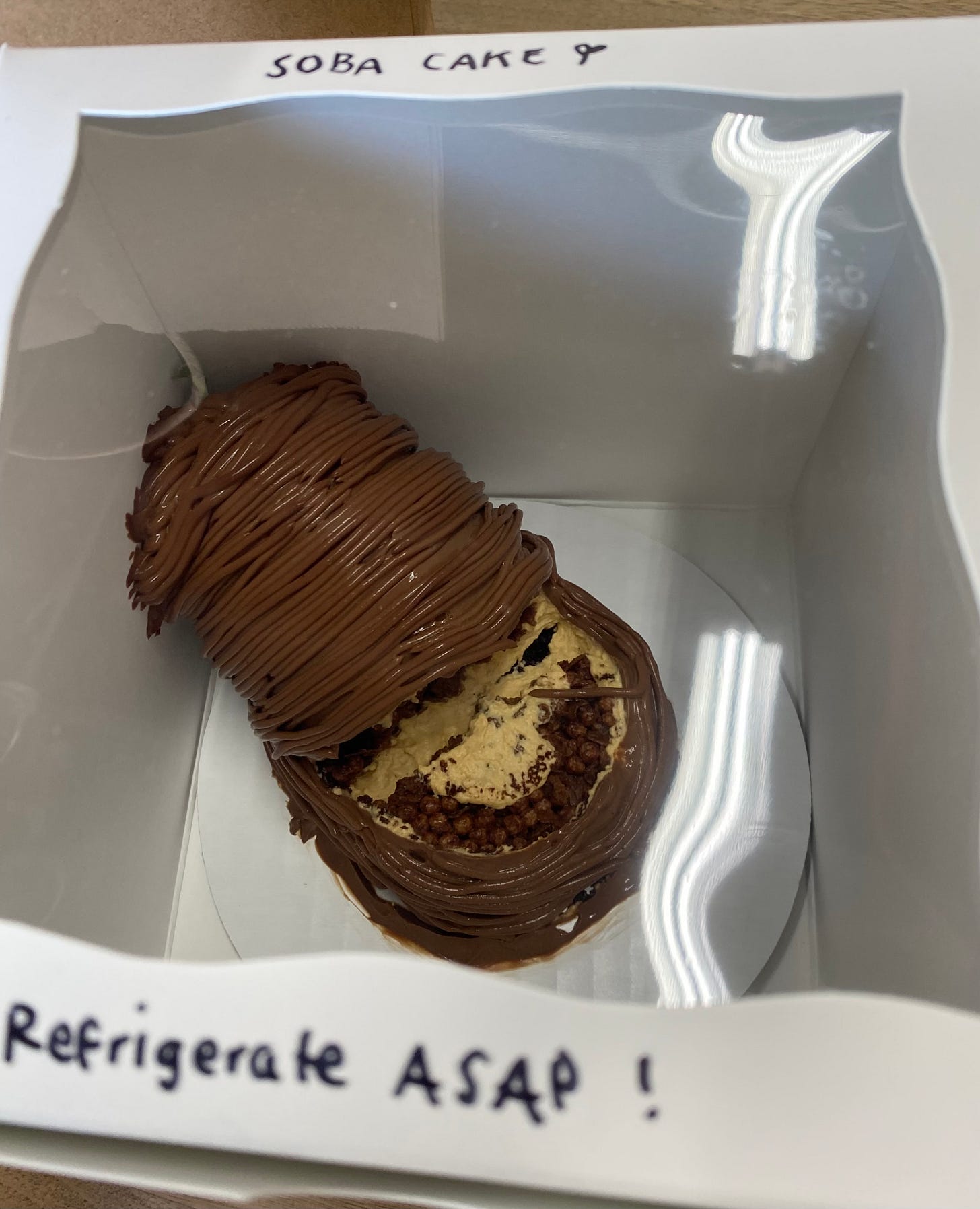Crazy bitches and ugly cakes
Soft & Quiet, The Love Witch, Greta, 90s erotic thrillers, and eating-habits of seductive psychopaths
As an ardent fan of cream puffs, I was beyond thrilled to receive a box of them for my birthday, and my excitement swiftly reassembled into astonishment when I saw that the choux, piped fresh with diplomat cream, had been skillfully molded and baked into the shape of a swan. They’re the workmanship of
, who writes , and I had the bittersweet pleasure of devouring these admirable beauties alongside whiskey and champagne cocktails, with her and a few other former-colleagues-turned-current-friends, a most precious and undervalued class of individual. Whimsical desserts, strong drinks, the gift of friendship: what more could I ask for?The swans are a vision of beauty, but elsewhere cakes are running afoul of traditional upheld aesthetics, which I’ll explore in this issue along with a slew of films.
i. The Last Seduction
ii. Soft & Quiet
iii. Jade // Final Analysis
iv. Greta
v. The Love Witch
vi. Why do movie villains eat cake?
vii. Subversive cakes IRL
In other news:
I interviewed Romanian auteur Christian Mungiu on the occasion of his latest film R.M.N., in theaters now
talked to landscape documentarian Nikolaus Geyrhalter about Burning Man his trash documentary for Bomb Magazine
reviewed the gently swooning The Eight Mountains for Literary Hub
researched the best design-forward teapots for Architectural Digest
THE LAST SEDUCTION
John Dahl, 1994
I don't know that I’ve witnessed a femme fatale as uncompromisingly immoral and masterfully committed to her relentless grift as Bridget Gregory alias Wendy Kroy, indelibly inked in pitch pitch black by actress Linda Fiorentino who is now essentially retired.
After double crossing her unscrupulous doctor-husband (Bill Pullman), she takes the money and runs north to bumblefuck nowhere, striking up a one-sided relationship with a dead-end loser (Peter Berg, creator of Friday Night Lights) who is as hopelessly moronic as she is rotten. Pulling him into her orbit, she spills a wickedness onto entire canvas, leaving us with no choice but to lay in thrall of her swaggering competence. May we never never cross paths.
SOFT & QUIET
Beth de Araújo, 2022
As if to vivify the regretful post-2020 election refrain that white women voted for Trump this debut feature showcases a motley crew of Karens and Beckys who put their money where their mouth is, backing their unsavory beliefs with impulsively dangerous actions.
I was made aware of this movie last year by a friend, who wouldn’t recommend it, per se, owing to the atrocities that occur on screen and subsequent negative energy it evokes, and I similarly extend the same forewarning. Provocative in the extreme and undeniably frightening in its realistic underpinnings, Soft & Quiet unleashes a visceral onslaught of fear in true Blumhouse fashion when a ladies’ coffee klatch emerges as a white-supremacist support group. Its shepherdess, an elementary school teacher (Stephanie Estes armed with both a bureaucrat's smile and a piercing eagle stare) urges her peers to harness the power of their femininity—the very essence epitomized by the “soft" and "quiet" of the film’s title—as a means to disseminate their zealous convictions or “vigorous” ideas to unassuming outsiders. The cherry pie she’s made is impeccably evocative: With a swastika scored into the crust, the humble dessert becomes an unexpected vehicle for their misguided beliefs, its wholesomeness deviously subverted by the symbol, which in no way can be mistaken as a totem of Eastern spirituality.
Shot as one long-take, in more or less real time, the film is animated by the chaotic descent of the hive mind, which eventually foments violence and occurs over a growing chorus of concerned grunts, stuck-in-the-throat howls, words replaced by animal savagery and argumentative wailings. The committed depiction of the characters’ moral malevolence forces you into submission. You’re made to feel complicit and the curtain-drop ending falls flat.
The entire viewing experience is akin to brunching next to a group of prattling white women, overhearing their prejudiced slights and then finding out they’re full-bore MAGA only to be forced into their car for a joy ride—except you’re never forced, not really. There exists a simple escape: you can just stop watching the movie.
The film is redeemed for me by its casting of Eleanor Pienta, the third and final member of the Cocoon Central Dance Team to receive feature film billing, a hopeful indication of larger, meatier roles to come.
JADE (William Friedkin, 1995)
+ FINAL ANALYSIS (Phil Joanou, 1992)
Two San Francisco-set films, both more neo-noir than erotic thriller. The lady is a vamp but may or may not be crazy, and it’s up to two earnest yet laconic men to find out. A sense of the lurid has been forsaken for drama, fostering a sense of stiffness, and not in the way one wants. These are passable C+ movies for when you’ve exhausted the rest of the list.
The proper elements are all there in Friedkin’s self-professed favorite film, but none of it gels. The plot feels mechanical, the car chase perfunctory, the BDSM undertones undervalued. The film’s solitary standouts are the exaggerated shirt collars on Linda Fiorentino. Riding the success of The Last Seduction, she lays a psychologist/boss bitch with an aggressive sexual appetite that her husband, played by Chaz Palminteri, won’t indulge.
Final Analysis is slightly better and more coherent. Though fluent in the language of noir and keen on paying homage to Vertigo (whirling staircases, doubling blondes played Uma Thurman and Kim Basinger, and memory-loss side-motifs) it struggles to make dramatic impact.
SINGLE WHITE FEMALE
Barbet Schroeder, 1992
The Ansonia, a landmark building steeped in New York allure, becomes a silent witness to the psychological unraveling of Hedra Carlson (Jennifer Jason Leigh). Hedy, as she is called, develops an unhealthy fixation on her roommate Allie (Bridget Fonda) and becomes determined to dismantle her life.
The somewhat sensational plot is rendered wholly believable by Leigh’s credible performance as an emotionally unstable type, oscillating between coquettish naif and and sinister obsessive, that distinct voice of hers, honeyed and craven, mirroring her psyche. Schroder’s sleek direction and adroit pacing helps to elevate slasher flick, if not of interest to the intellectuals, then certainly the fashion-minded NYC movie dilettantes. (On my queue: Karina Longworth dedicated an episode of her podcast to this movie as it relates to Fatal Attraction, which I covered here.)
Nestled within this film is a broader commentary on the pervasive violence inflicted upon women, as Allison is subjected to employer’s harassment. Notable supporting performances include Stephen Tobolowsky and Peter Friedman, aka Frank from Succession, as the gay neighbor who inadvertently hears everything through the infernal air vents.
GRETA
Neil Jordan, 2018
Cooing about in self-pity, Chloe Moretz plays a Manhattan waitress who latches onto Isabelle Huppert’s mother-figure, an elegant but needy Hungarian widow named Greta. You know she’s a sociopath when she explodes Chloe’s phone with a hundred texts and 38 missed calls. And yet, Greta is maybe only the third most fucked-up-in-the-head character Isabelle Huppert has played (See: The Piano Teacher, La Ceremonie, par example).
For the uninitiated, Huppert is a lot like the French Laura Dern, inciting stans with hair-raising talent and a touch of menace. Dialing back her game to fit smaller screens or lesser films like these, she knows better than the rest of us that the B-pictures have always proved sufficient canvas for a true artiste. This movie, set in fake-generic NYC is a highly quaffable punch of stalker psycho-drama, better than it has any right to be. Never doubt Queen Isabelle.
THE LOVE WITCH
Anna Biller, 2017

In a film that looks like a dollhouse is proof that a feminist film does not need a feminist protagonist. A sly examination of gender roles, The Love Witch teases out the societal expectations concerning women, their latent sexual powers, and supposed sorcery over men.
Anna Biller expertly combines two things: an extreme dedication to the superficial signifiers (haircuts, baubles, vernacular, et all) of a certain period in American history and critiquing the mores of that era and beyond. This homage to midcentury Technicolor camp delivers handsomely on stunning set-dressings and decor (c/o Biller herself, responsible for all the marvelous costuming and art direction) and looks so much like the thing that you almost forget it’s more than gorgeous pastiche.
Recommended if you like: Audrey Horne from Twin Peaks, Astropoets, searching for Victorian objects on Etsy, redecorating your home to adhere to a singular unifying aesthetic.
The Love Witch is streaming on MUBI. Get 30 days free with my link.
THE VILLAINS: LET THEM EAT CAKE
No qualms about it: cakes mean indulgence but on screen, indulgence equals villainy. The most glaring examples dwell in the work of Quentin Tarantino. I’m talking of course about Leonard DiCaprio’s Calvin Candie, the slave-owner who partakes sin white cake in Django Unchained and the apfel strudel savored by Christoph Waltz’s SS colonel in Inglorious Basterds.
It’s not just that the bad guys are exemplary gourmands and that eating cake suggests their penchant for the heinous and sinful. These sweets are deployed as a power play, an opportunity to exert impressively wicked authority over someone else. Movie antagonists artfully wield their dessert like weapons and anti-heroines take similar note, but to slightly different effect.
Femme fatales reclaim confectionary indulges along with their villain-status. Witness Carey Mulligan scarfing down a jelly doughnut with harrowing force, a proclamation of her power in Promising Young Woman. In the aforementioned The Love Witch, director Anna Biller strategically accessorizes frosting heavy layer to double down on the girliness and the film's exploration femininity. In Park Chan-wook’s Lady Vengeance, coincidentally a Tarantino fave, cakes become intertwined with themes of redemption, forgiveness, and moral transformation. The revenge-seeking protagonist buries her head into a pure white gateau, reckoning with lost innocence.
REAL LIFE CAKE SUBVERSIONS
If you’re following food trends, you’ll have noticed that cakes have take an uglier and messier (
) turn lately, undermining the sleek and polished presentations as a corrective to the fake perfection of Instagram.Mina Park of Ninetynine Patisserie (99’s Substack) adheres to a tight aesthetic but finds subversion in other ways, by eschewing traditional European buttercream in favor of whipped creams and even mung beans and reclaiming Paris Baguette-style Asian fruit cakes in the process.
Natasha Pickowicz—the renowned baker responsible for my recently acquired fondness for the layered cakes—pushes against the constraints of the dessert with her aptly titled debut More Than Cake, which includes savory recipes and uses baking as a driving force of community and social justice.
On my birthday I attended her book signing and veritable cake feast at Stissing House where the Shaker setting was gussied up by the presence of black sesame chiffon and cream cheese sheetcake, shallow silver platters of strawberry panna cotta, and mocha choux strewn nakedly atop the spartan table.
Flushing dessert parlor Gong Gan is already insta-famous for their mushroom-embellished cheesecake that looks like it was created by Keebler elves on acid. They continue to push aesthetic boundaries with a new soba cake, in which dark chocolate mousse has been impressively piped around a three-layer cake to resemble a mound of buckwheat noodles or less eloquently, a stringy poop emoji. The wee sprig of sage planted on top provides an elegant contrast visually and flavor-wise since the cake skews on the sweeter side—chocolate cake alternating with banana-caramel cream and a round of crisped rice, a la Krackle or Buncha Crunch—and an earthy tang would go a long way in alleviating the palette. That or coffee, which is is also excellent here.
The “soba” is accompanied by a dipping sauce of brown butter. Had I dined in, i would’ve bisected the cake vertically and poured it down the middle like hot lava. Alas I transported this in the car against their recommendations, much to my chagrin—it fell.
Seeking a friend for my next visit to indulge in their magnificent array of croffles, the foremost croissant innovation that was also unrecognized by the dusty-ass New York Times. Rude!!














I looked up a trailer and second review for Soft & Quiet. I can’t help but wonder if this is the kind of film that intends to be provocative and then pulls in an unintended audience of sympathizers. Scary either way!